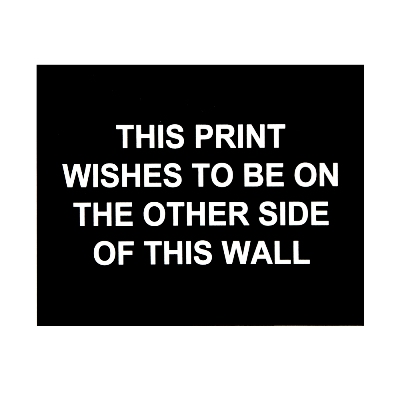
Details
Artist
Styles
Original 5 color lithograph and screenprint - Published byGemini G.E.L. Los Angeles - Corlett 114, Gemini No 390 - Printed by Ken Tyler, Los Angeles - Image: 30 1/8 x 21 3/8in (76.3 x 53.8cm) - Sheet 39 x 29 3/8in (99.1 x 74.2cm) // Mirror #9 by Roy Lichtenstein, created in 1972, is a limited edition print that blends lithography and screenprint techniques. Known for his iconic pop art style, Lichtenstein uses bold lines, primary colors, and his signature Ben-Day dots to reinterpret everyday objects and visuals. In this piece, the image of a mirror is abstracted into geometric forms and patterns, with blue and black dots on a white background giving the illusion of reflection and transparency. Yellow accents break up the composition, adding to the sense of depth. Measuring approximately 99.1 x 74.2 cm, this artwork encapsulates Lichtenstein's exploration of visual perception, questioning how we interpret familiar objects when they are deconstructed and rendered through modern artistic techniques.
Mirror #9, 1972
form
Medium
Size
99.1 x 74.2 cm
- Inches
- Centimeters
Edition
Price
Details
Artist
Styles
Original 5 color lithograph and screenprint - Published byGemini G.E.L. Los Angeles - Corlett 114, Gemini No 390 - Printed by Ken Tyler, Los Angeles - Image: 30 1/8 x 21 3/8in (76.3 x 53.8cm) - Sheet 39 x 29 3/8in (99.1 x 74.2cm) // Mirror #9 by Roy Lichtenstein, created in 1972, is a limited edition print that blends lithography and screenprint techniques. Known for his iconic pop art style, Lichtenstein uses bold lines, primary colors, and his signature Ben-Day dots to reinterpret everyday objects and visuals. In this piece, the image of a mirror is abstracted into geometric forms and patterns, with blue and black dots on a white background giving the illusion of reflection and transparency. Yellow accents break up the composition, adding to the sense of depth. Measuring approximately 99.1 x 74.2 cm, this artwork encapsulates Lichtenstein's exploration of visual perception, questioning how we interpret familiar objects when they are deconstructed and rendered through modern artistic techniques.
- Recently Added
- Price (low-high )
- Price (high-low )
- Year (low-high )
- Year (high-low )
Roy Lichtenstein
Before The Mirror (from Mirrors Of The Mind Portfolio), 1975
Limited Edition Print
Lithograph
USD 19,500
Roy Lichtenstein
Interior With Chair From The Leo Castelli 90th Birthday Portfolio, 1997
Limited Edition Print
Screen-print
USD 30,000 - 40,000
Roy Lichtenstein
Inaugural Print From The Inaugural Impressions Portfolio, 1977
Limited Edition Print
Screen-print
USD 25,000 - 35,000
Roy Lichtenstein
Reflections On Minerva, 1990
Limited Edition Print
Mixed Media
USD 80,000 - 100,000
Roy Lichtenstein
Pistol (from Banner, Multiples Calendar, 1968
Limited Edition Print
Screen-print
USD 4,600
Roy Lichtenstein
Apple And Lemon (from Seven Apple Woodcuts), 1983
Limited Edition Print
Woodcut
USD 14,850
Roy Lichtenstein
Red And Yellow Apple From Seven Apple Woodcuts, 1983
Limited Edition Print
Woodcut
USD 20,000 - 30,000
Roy Lichtenstein
Two Paintings: Dagwood From The Paintings Series, 1984
Limited Edition Print
Mixed Media
USD 80,000 - 100,000
Roy Lichtenstein
Reflections On Crash From Reflections Series, 1990
Limited Edition Print
Mixed Media
Inquire For Price
Roy Lichtenstein
Reflections On Expressionist Painting From The Carnegie Hall 100th Anniversary Portfolio
Limited Edition Print
Screen-print
USD 60,000 - 70,000
Roy Lichtenstein
De Denver Au Montana, Départ 27 Mai 1972 (1), 1991
Limited Edition Print
Etching And Aquatint
USD 12,500
Roy Lichtenstein
De Denver Au Montana, Départ 27 Mai 1972 (II), 1991
Limited Edition Print
Etching And Aquatint
USD 12,500
Roy Lichtenstein
Liberté, From Mémoire De La Liberté, 1991
Limited Edition Print
Serigraph
EUR 19,750
Roy Lichtenstein
Sweet Dreams, Baby!, 1965
Limited Edition Print
Screen-print
Currently Not Available
What is Lettrism?
Lettrism is an art form that uses letters, words, and symbols to create artwork. The movement was established in Paris in the 1940s and later gained popularity in the 1950s in America. Lettrisme is the French spelling of the movement's name, derived from the French word for letter.

































































